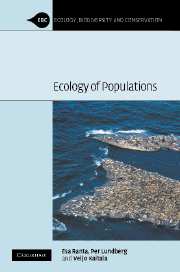Book contents
- Frontmatter
- Contents
- Preface
- 1 Introduction
- 2 Population renewal
- 3 Population dynamics in space – the first step
- 4 Synchronicity
- 5 Order–disorder in space and time
- 6 Structured populations
- 7 Biodiversity and community structure
- 8 Habitat loss
- 9 Population harvesting and management
- 10 Resource matching
- 11 Spatial games
- 12 Evolutionary population dynamics
- 13 Epilogue
- References
- Index
12 - Evolutionary population dynamics
Published online by Cambridge University Press: 02 December 2009
- Frontmatter
- Contents
- Preface
- 1 Introduction
- 2 Population renewal
- 3 Population dynamics in space – the first step
- 4 Synchronicity
- 5 Order–disorder in space and time
- 6 Structured populations
- 7 Biodiversity and community structure
- 8 Habitat loss
- 9 Population harvesting and management
- 10 Resource matching
- 11 Spatial games
- 12 Evolutionary population dynamics
- 13 Epilogue
- References
- Index
Summary
The interface between the evolution of life history traits and population dynamics in temporally and spatially variable environments is the topic of this chapter. Thus, the frame for the life history processes is set by spatial and temporal fluctuations in population density. Here, we will focus primarily on modes of reproduction and we are especially interested in whether alternative reproductive strategies can co-exist in a population. We show that spatially structured populations may allow co-existence of various life history strategies that do not easily co-exist in a nonstructured environment. Also, intrinsic and external temporal fluctuations in the environment tend to enhance polymorphism in certain traits, e.g., iteroparity versus semelparity and whether monogamy or polygamy are favored reproductive strategies. In this chapter, we largely omit genetics, but a short comment on that aspect is found towards the end.
All life history problems are related to optimizing reproduction. One central question is how individuals allocate resources to survival and reproduction, and, for example, how offspring number, size, and sex are decided. When we put the evolution of life histories and optimizing behavioral decisions into the context of population dynamics, we will change our focus from optimizing to evolutionary stability. We may introduce, say, different reproductive behavioral patterns in our population models and ask which one of them will be an ESS. Technically, as is the tradition in the ESS literature, we will assume two or more distinct phenotypes competing (Maynard Smith 1982; Bulmer 1994).
- Type
- Chapter
- Information
- Ecology of Populations , pp. 300 - 332Publisher: Cambridge University PressPrint publication year: 2005



